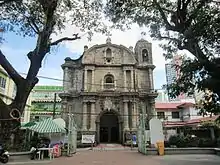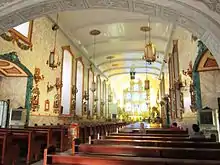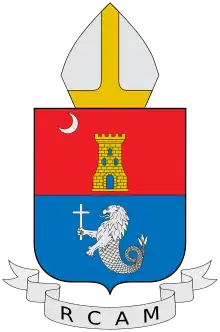San Pedro Macati Church
The San Pedro Macati Church, also known as Saints Peter and Paul Parish Church, is a Roman Catholic Church located in Makati Poblacion, the oldest part of Makati and for that reason, the cultural and heritage barangay of Makati, Philippines. In front of the church facade is Plaza Cristo Rey, which was formerly the San Pedro de Macati Cemetery. The Poblacion Church is a government-recognized cultural property based on the official list provided by the National Historical Commission of the Philippines. After 394 years, the Church was re-dedicated, the first dedication happened in 1620 when it became a parish church, the next after the reconstruction of the facade in 1796 and finally again, on the 30th day of January, 2015. The dedication was led by Luis Antonio Cardinal Tagle, D.D., Archbishop of Manila, con-celebrated by Rev. Msgr. Gerardo O. Santos, Ed.D, Parish Priest, bishops, and priests.
| San Pedro Macati Church | |
|---|---|
| Sts. Peter and Paul Parish Church | |
| Poblacion Church | |
San Pedro de Macati Church | |
 | |

| |
| 14.566130°N 121.031385°E | |
| Location | 5539 D.M. Rivera Street Poblacion, Makati |
| Country | Philippines |
| Denomination | Roman Catholic |
| History | |
| Status | Parish church |
| Founded | 1620 |
| Founder(s) | Fr. Pedro de los Montes |
| Dedication | Peter and Paul |
| Architecture | |
| Functional status | Active |
| Heritage designation | Philippine Historical Research and Markers Committee |
| Designated | around 1937 |
| Style | Baroque |
| Administration | |
| Archdiocese | Manila |
| District | District of Makati |
| Clergy | |
| Archbishop | Sede vacante |
| Auxiliary Bishop(s) | Broderick Pabillo |
| Priest(s) | Rev. Msgr. Gerardo O. Santos, Ed.D, P.C. |
| Assistant | Rev. Fr. Gabriel A. Paraan, Jr. |
History

Before the land seizure of the Spanish, the area of today's San Pedro de Macati was part of the Kingdom of Sapa or Namayan, ruled by the Rajah Kalamayin whose residence was in Namayan, now part of Sta. Ana, Manila.[1] The Franciscan missionaries were the first to convert the aboriginal Tagalog of Sapa to the Christian Faith by 1578, after they had turned the original barangay into a visita called Sta. Ana de Sapa in 1570.
In 1589, Capitan Pedro de Brito, then an aide to the Spanish Army Chief of Staff, purchased today's church premises as part of a large property with a public bid of 1400 pesos, and installed his encomienda called "Hacienda Pedro".
On July 1, 1608, Capitan Pedro de Brito, now the newly elected Alferez General, and his wife Ana de Herrera donated part of their land to the Jesuits. Fr. Gregorio Lopez S.J. accepted the deed of donation and an endowment of 14,000 pesos for a house of probation. This house and the church were to be built in the highest hill in the area called Buenavista and were to be placed under the patronage of Saint Peter, the donor's name patron.
Construction of the first church was finished in 1620 under the direction of Fr. Pedro delos Montes S.J. As the Jesuit encomienda began to earn at least 30,000 pesos annually from the production of earthenware, their vision of building an imposing structure could begin to be realized. The church known as San Pedro y Pablo Viejo was made from hewn stone, pebbles, and gravel mixed with mortar. Its facade is dominated with a three tiered papal tiara with the cross keys of Saint Peter.
In 1718, an ivory image of the Blessed Virgin Mary depicted as Virgen de la Rosa (Virgin of the Rose) was brought from Mexico to the Philippines through the Manila-Acapulco Galleon Trade by Jesuit Fr. Juan Delgado. This image of the Virgin Mary was enshrined in this church and was frequently venerated due to a relic of the Virgin's hair supposedly encapsuled in the image's breast.
According to Nick Joaquin, this concept was backed by Fr. Pedro Murillo's description in his "Historia de la Provincia de Filipinas de la Compania de Jesus":
“Your most holy image of the Nuestra Señora de la Rosa has on her breast a most precious treasure, greater than those which Tharsis had in is opulence, or Ophir with his most valuable metals can offer. This is the strand of hair of her most holy head, whose authenticity I read with great admiration. In the vast extent of the Indies that I know of, there exists no similar reliquary.”[2][3]
Unfortunately, the reliquary got lost together with the ivory hands and head of the statue in the Revolution of 1899. There remains an oval cavity in the upper body, the missing pards have been restored using wood as a material instead of ivory.[2][4]
In Lourdes Policarpio's view, the Virgin’s title stems from "Our Lady as the Mystical Rose" or “Rosa Mystica.” In Lucca, Italy, the feast of "Our Lady of the Rose" is celebrated on January 30. It is believed that three roses were found in the arms of Our Lady on January.[5] when a deaf mute shepherd see the appearance of the Lady. He has able to speak after the apparition of Our Lady of Roses.
In the church parish, there are two famous festivals or fiestas held on June 29, the feast of Apostles Peter and Paul, and June 30, the feast of "Nuestra Señora dela Rosa". The "Panatang Sayaw", as the Bailes de los Arcos (Dance of the Arches) are called, are an old tradition going back at least to the beginnings of the 19th century. It is a ritual of praise and thanksgiving to the saints Peter and Paul and the Virgen de la Rosa.[6]
The church was destroyed during the British occupation of Manila in 1762. It was reconstructed much later in 1849 using stones from nearby Guadalupe in Makati and Meycauayan in Bulacan province. Other materials used
include yakal and molave as wood materials, and kapre shells for windows.[7] baticulin (scientific name: Litsea leytensis")
and guijo timbers (scientific name:
"Shorea guiso" also known as "Red Balan")
and conchas or seashells for its windows.
After the Jesuits’ expulsion the ownership changed. The Makati hacienda was reclaimed by the government and was sold in public auction in 1795 to Don Pedro de Garuga, Marquis of Villa Medina. Through the next half-century, the property changed hands three times, until, in 1851, it was bought by Don Jose Bonifacio Roxas, the founding father of the Roxas-Ayala-Zobel clan, who built a family manor on the riverbank, what is today's Poblacion's river park, "Casa Hacienda Park".[8]
During the Philippine–American War from 1899 to 1902, the church was used as a hospital to tend wounded American soldiers. American volunteers also camped on church grounds.[9] This stay however resulted in the loss of the ivory head and hands of the Virgen de la Rosa.
Over the years the Makati Church underwent several renovations and changes in the design but most of its features like the reredos and the church bells are still original.[7]
On October 29, 2018; the Congregation for Divine Worship and Discipline of the Sacraments granted a Canonical coronation to the image of the Virgen de la Rosa. The rite of crowning took place on March 16, 2019 presided by the Papal Nuncio to the Philippines.[10]
Architecture
The church structure follows the Baroque style of architecture. Its architectural feature of a single rectangular nave consisting of an apse and sacristy is typical of churches during the Spanish Colonial Period.[11] The altar with its original carved reredos with motifs of various flowers and fruits following the Baroque Rococo tradition can still be found in the church.[12]
Cultural property and historical marker
The Saints Peter and Paul Parish Church is a government-recognized important cultural property with the placement of a historical marker around 1937 by the Philippine Historical Research and Markers Committee, the precursor to the present National Historical Commission of the Philippines.[13]
Parish Priests
| Name | Years of Pastorship | Present Assignment |
|---|---|---|
| Rev. Msgr. Jose Dimbla | 1899 to 1904 | deceased |
| Rev. Fr. Tirso Tomacruz | 1918 | deceased |
| Rev. Fr. Adriano Cuerpo | 1920 to 1929 | deceased |
| Rev. Fr. Getulio Ingal | 1930 | deceased |
| Rev. Fr. Osmundo Aguilar | 1931 to 1939 | deceased |
| Rev. Fr. Lazaro Ochuga | 1939 to 1951 | deceased |
| Rev. Fr. Francisco Teodoro | 1955 to 1974 | deceased |
| Rev. Fr. Pablo Dimagiba | 1974 | |
| Rev. Msgr. Feliciano Santos | 1974 to 1980 | deceased |
| Rev. Msgr. Antonio B. Unson, H.P. | 1980 to 2006 | deceased |
| Rev. Fr. Estelito Villegas | 2006 to 2014 | Parish Priest of Tondo Church |
| Rev. Msgr. Pedro Gerardo O. Santos, Ed. D., PC | December 15, 2014 to present | |
Former Priests
| Name | Years of Pastorship | Previous Assignment |
|---|---|---|
| Rev. Fr. Virgilio Soriano | 1937 | |
| Rev. Fr. Pio Palad | 1951 | |
| Rev. Fr. Dalmacio Eusebio | 1960 | Parochial Vicar |
| Rev. Fr. Amado Ligon, Jr. | 1967 | Parochial Vicar |
| Rev. Msgr. Augusto Pedrosa | 1968 | Parochial Vicar |
| Rev. Fr. Celso Sta. Maria | 1970 | Parochial Vicar |
| Rev. Fr. Rogelio Positar, OSA | 1996 | Attached Priest |
| Rev. Fr. Jaime Bautista | 1996 | Parochial Vicar |
| Rev. Fr. Wilmer Rosario, JCD | 2006 | Parochial Vicar |
| Rev. Fr. Estanislao Amper | Parochial Vicar | |
| Rev. Fr. Roy Bellen | 2006 - 2011 | |
| Rev. Fr. John Patrick D. Calimlim | 2008 - 2015 | Parochial Vicar |
| Rev. Fr. Ryan O. Diño, SVD | 2016 | Attached Priest |
| Rev. Fr. Reyann Orlandes, SVD | 2017-2018 | Attached Priest |
Present Priest
| Name | Assignment |
|---|---|
| Rev. Fr. Gabriel A. Paraan, Jr. | Asst. Parish Priest/ Parochial Vicar |
| Rev. Fr. Boy Aurelio T. Buhay | Resident Priest |
| Rev. Fr. Alwin Bobis | Resident Priest |
| Rev. Fr. William M. Parde, Jr. | Resident Priest |
Chapel Communities
- Our Lady of Lourdes (Hondradez) Chapel (Brgy. Olympia, Makati City)
- Holy Cross (Sampalucan) Chapel (Brgy. Olympia, Makati City)
- Sacred Heart (Rockwell) Chapel (Power Plant Mall, Brgy. Poblacion, Makati City)
- San Fabian (Olympia Village) Chapel (Brgy. Olympia, Makati City)
- San Padre Pio (Century) Chapel (Century Mall, Brgy. Poblacion, Makati City)
References
- Scott, William Henry (1994). Barangay: Sixteenth Century Philippine Culture and Society. Quezon City: Ateneo de Manila University Press. ISBN 971-550-135-4.
- "Nuestra Senora de la Rosa".
- Almanac for Manileños by Nick Joaquin; Nuestra Senora de la Rosa and her Young Dancing Maidens by Lourdes Policarpio
- Almanac for Manileños by Nick Joaquin Nuestra Senora de la Rosa and her Young Dancing Maidens by Lourdes Policarpio
- Almanac for Manileños by Nick Joaquin; Nuestra Senora de la Rosa and her Young Dancing Maidens by Lourdes Policarpio
- Old Makati and the Bailes de los Arcos by Alejandro Roces
- Algarme, Claire (2014-05-11)."File:Sts. Peter and Paul Church 9.JPG". Wikimedia Commons. Retrieved on 2014-11-26.
- Joaquin, Nick (1979). "Almanac for Manileños".
- "Philippine–American War".
- "'Virgen dela Rosa de Macati' canonically crowned". CBCPNews. Retrieved 2019-06-17.
- "Makati's Historic Churches". 2014-04-19.
- "Sts. Peter and Paul Parish Church". Archived from the original on 2014-05-12.
- Administration. "National Registry of Historic Sites and Structures in the Philippines". National Historical Commission of the Philippines. Retrieved on 2014-11-26.

